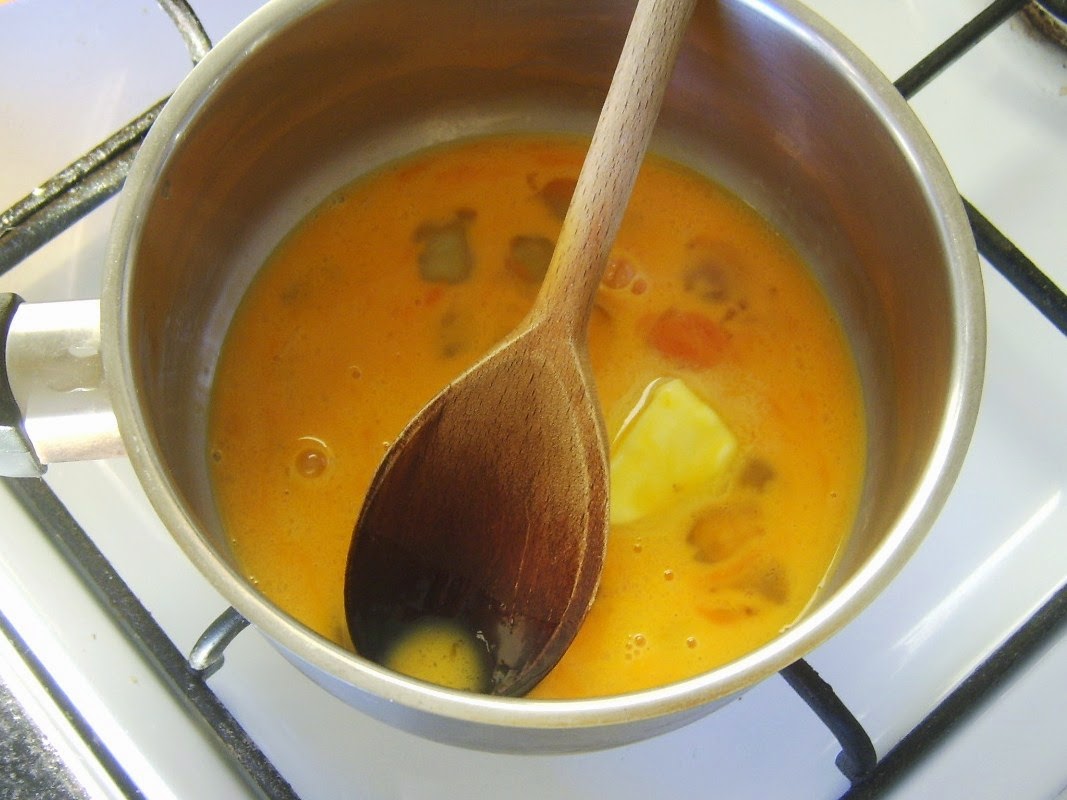 |
| Scrambled quail eggs with mini cocktail sausages and deep fried potato skins |
If you are in the UK and you think of sausages, egg and chips, you will not probably conjure up in your mind an image much like the one above! You are more likely of course to think of chips, bangers and a fried egg. While this dish is very different, it is essentially however still sausages, egg and chips. It came about in the first instance when I was thinking of a way to cook the remaining quail eggs I had from my recent gift pack (see an earlier post). I wanted to cook them in a way I had never cooked quail eggs before, so I decided to try them scrambled.
Probably the main reason why we wouldn't automatically think of scrambling quail eggs is because they are of course so small. I used eight of them in this dish and the resultant scrambled egg quantity probably wasn't even as much as would be provided by two chicken eggs. As the eggs are so small, I decided to use small cocktail sausages to serve with them and instead of making conventional homemade chips, I thought deep fried potato skins may work well as part of the combination. I'm glad to say that although the finished dish was probably more of a starter/appetizer in terms of quantity than a main course, it was really, really tasty.
 |
| Parboiling potato skins |
Ingredients
Skins from 2 medium sized baking potatoes (or as required)
Salt
6 Wee Willie Winkie sausages (or similar cocktail sausages)
Vegetable oil for frying
8 fresh quail eggs
Little bit of butter
White pepper
Malt vinegar
2 or 3 shredded basil leaves to garnish
 |
| Parboiled potato skins ready to be chilled |
Directions
When you're peeling the potatoes, it's a good idea to try and slice the skins off as evenly as possible. I always use a knife for peeling potatoes and never a vegetable/potato peeler. I find it much easier. That is of course down to personal preference.
Put the skin pieces in to a pot of cold, salted water and bring to a simmer for five minutes. Drain well through a colander, allow to steam off for five more minutes then refrigerate in a plastic dish for at least an hour to chill.
 |
| Wee Willie Winkie mini cocktail sausages |
The Wee Willie Winkie (or similar) sausages should be gently fried in a little oil over a low to medium heat for about ten minutes, turning frequently.
 |
| Gently frying Wee Willie Winkie Sausages |
Quail eggs are awkward to deal with in any way because they are so small. The best way I've found to break them is with the blunt edge of a reasonably thick bladed table knife.
 |
| Fresh quail eggs |
Break the quail eggs straight in to a small saucepan. Don't worry about breaking a yolk or two - they are soon going to be a lot more broken! If you do get any shell in the pan, wet your fingers in cold water and press them on the bits of shell and they will stick to your fingers. Add a little bit of butter but don't season at this stage.
 |
| Quail eggs ready for scrambling |
Start the potato skins deep frying in a deep pan of very hot oil (or your deep fryer) before you start scrambling the quail eggs.
 |
| Deep frying potato skins |
Put the quail eggs pan on to a low to medium heat. Begin stirring with a wooden spoon and don't stop. Every twenty seconds or so, remove from the heat but keep stirring, so as the eggs don't overcook.
 |
| Starting to scramble quail eggs |
During one brief respite from the heat for the eggs, lift the sausages and potato skins to a plate covered with kitchen paper to drain.
 |
| Potato skins and sausages are drained on kitchen paper |
When the quail eggs are almost done, turn off the heat. Add the sausages, season with a little white pepper and carefully fold through to combine.
 |
| Wee Willie Winkie sausages are added to scrambled quail eggs |
With the wooden spoon, spoon the quail eggs and sausages in to the centre of a deep serving plate.
 |
| Scrambled quail eggs and Wee Willie Winkie mini sausages |
Season the potato skins with salt and malt vinegar and arrange attractively around the scrambled quail eggs and sausages. Garnish the eggs with the sliced basil leaves.
 |
| Potato skins are arranged around scrambled quail eggs and sausages |











































